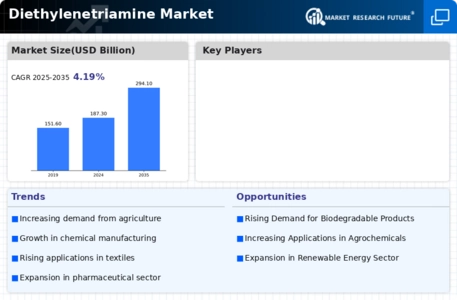Market Trends
Key Emerging Trends in the Diethylenetriamine Market
The Diethylenetriamine (DETA) Market is undergoing significant trends influenced by diverse factors including industrial applications, technological advancements, and sustainability considerations. Here's a comprehensive overview of the market trends presented in a paragraph with a pointer format:
Growing Demand in Epoxy Resins Production: A prominent trend in the Diethylenetriamine Market is the increasing demand driven by the production of epoxy resins. DETA is a crucial component in the curing process of epoxy resins, contributing to their exceptional adhesion, durability, and chemical resistance. The expanding applications of epoxy resins in industries such as construction, automotive, and electronics are propelling the demand for DETA, as these resins are widely used in coatings, adhesives, and composite materials.
Focus on Sustainable and Bio-Based DETA: Sustainability is shaping market trends, leading to a growing focus on sustainable and bio-based DETA production. With environmental concerns driving industries towards greener alternatives, manufacturers are exploring bio-based sources and sustainable production processes for DETA. This aligns with the broader industry movement towards reducing the carbon footprint and environmental impact associated with chemical production.
Rising Application in Polyamides and Textile Chemicals: The Diethylenetriamine Market is witnessing increased application in the production of polyamides, which are essential in the manufacturing of fibers, textiles, and engineering plastics. DETA serves as a key building block in the synthesis of polyamides, contributing to their strength and versatility. The growth of the textile industry and the demand for high-performance materials are driving the use of DETA in the production of textile chemicals and nylon-based products.
Technological Advancements for Enhanced Purity and Quality: Continuous technological advancements in DETA production processes are influencing market trends. Manufacturers are investing in research and development to improve the efficiency of DETA synthesis, enhance the purity of the final product, and reduce impurities. Advanced technologies, including refining and purification processes, are being implemented to meet the stringent quality requirements of various industries.
Expansion in the Water Treatment Industry: The water treatment industry is emerging as a significant consumer of DETA, particularly in the production of chelating agents and corrosion inhibitors. DETA's ability to form stable complexes with metal ions makes it valuable in water treatment applications. As the demand for effective water treatment solutions grows, the market for DETA in water treatment is expanding, driven by its use in formulations designed to address corrosion and scale issues.
Globalization and Strategic Collaborations: The Diethylenetriamine Market is experiencing globalization as key players expand their global presence through strategic collaborations, partnerships, and acquisitions. Companies are forming alliances to strengthen their market position, leverage each other's expertise, and tap into emerging markets. The globalization trend reflects the industry's efforts to diversify its geographic footprint and enhance its competitiveness on a global scale.
Challenges in Raw Material Availability: The market faces challenges related to the availability and pricing of raw materials used in DETA production, such as ethylene diamine. Fluctuations in the supply and cost of these raw materials can impact the overall production cost of DETA. Manufacturers are actively managing these challenges by optimizing their supply chain strategies, exploring alternative raw material sources, and implementing cost-effective production processes.
Increasing Demand in the Oil and Gas Sector: The oil and gas industry is a significant consumer of DETA, particularly in gas sweetening processes where DETA is used as a selective solvent for the removal of hydrogen sulfide (H2S) and carbon dioxide (CO2) from natural gas. As global energy demand continues to rise, the demand for DETA in gas sweetening applications is expected to increase, contributing to the overall growth of the market.
Research Focus on New Applications and Formulations: Ongoing research is focusing on exploring new applications and formulations for DETA. Manufacturers are investigating novel uses in areas such as pharmaceuticals, personal care products, and agrochemicals. The versatility of DETA as a multifunctional amine is driving the exploration of innovative formulations to meet the evolving needs of diverse industries.


 Source: Secondary Research, Primary Research, Market Research Future Database, and Analyst Review
Source: Secondary Research, Primary Research, Market Research Future Database, and Analyst Review
Leave a Comment